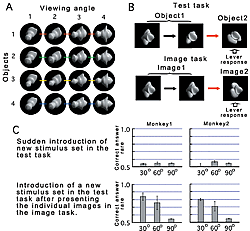Background
Fig. B: Test task (upper row) and image task (lower row).
Fig. C: The upper row shows the correct answer rates of the first day of introduction of the new stimulus set in the test task. The graphs show the responses to the second stimulus for each angle of rotation from the first stimulus to the second stimulus. The lower row shows the correct answer rates when the new stimulus set was introduced in the test task after having presented the individual images of the new stimulus set sufficiently in the test task.
An object's image varies as it rotates or as one's perspective changes. After experiencing an object only from a single viewing angle, we cannot differentiate the object from a similar object at a different viewing angle. However, if we have watched that same object rotate continually, we can recognize it at any given angle.
This phenomenon is traditionally explained as a result of consecutively seeing various images of the object in the rotation, which creates strong associations between the images' representations in the brain of the observer. This allows the person to recognize the object regardless of viewing angle. To test this hypothesis, we showed monkeys various images of an object seen from different viewing angles (views), without the experience of seeing the object's rotation. Then we tested their ability to recognize the object, regardless of the viewing angle.
Research Technique, Results
We performed each experiment using a stimulus set of four objects that closely resembled each other. An example of the stimulus set is seen in Fig.A. We then trained two monkeys to detect and respond to changes in the object (test task shown in upper row in Fig.B). One to five images of the object were presented sequentially, and the presentation period and the interval of each stimulus image was 0.5 second. We first presented one to four images of the first object (Object 1) viewed from different viewing angles, followed by an image of another object (Object 2). The monkey was trained to release the lever when an image of Object 2 was shown. Each correct response was rewarded with juice. The test task measured the monkey's ability to recognize objects independent of the viewing angle by letting the subjects determine whether the variation between the previous and current stimuli was simply that of the viewing angle or a change in the object.
After training the monkeys sufficiently, we next investigated how well they would respond to the introduction of a new stimulus set. In the first test, the new stimulus set was introduced suddenly and we checked their performances. The change in object occurred with the same probability in the second stimulus and after, so we analyzed performance by focusing only on the second stimulus. At this point, change in viewing angle (rotation angle) can be identified between the previous and current stimulus. Chance was set at 0.5 because the monkeys had to choose to release or hold the lever. The upper row of Fig. C shows the average rate of correct answers per rotation angle on the first day of training. Monkeys performed no better than chance at all rotation angles.
For the second test, we gave the monkeys a preparatory task that exposed them to each of the 16 images used in a new stimulus set, before we introduced the same stimulus set in the actual test task. Then we checked their performances. The preparatory task (the imaging task shown in the lower row of Fig.B) resembled the test task but differed from it in that the viewing angle did not change in each session. This means that the monkeys did not have the opportunity of learning the combination of images from different viewing angles of the same object in a single session. The image task tests were conducted over four weeks.
The results of the second test are shown in the lower row of Fig.C. The monkeys answered 80-85% correctly with a 30° rotation angle and 70 to 75% at a 60° degree angle. The two results were significantly higher than chance. At a 90° rotation angle, monkey performances were no better than chance.
Our results suggest that, after subjects have been accustomed to individual images in the image task, they can recognize the object even when the viewing angle changes up to 60°. This was the case, even when subjects had not specifically learned of the correspondence between images of different viewing angles.
Future Expectations
These results challenge the traditional hypothesis. Our findings suggest that the representations of a new object image are formed with image features that are consistent at multiple viewing angles. The visual system needs to recognize objects independently of the viewing conditions, and it seems then as a result of evolution or postnatal development our monkeys learned to recognize objects based on image features that do not change dramatically with rotation. These features are stable.






